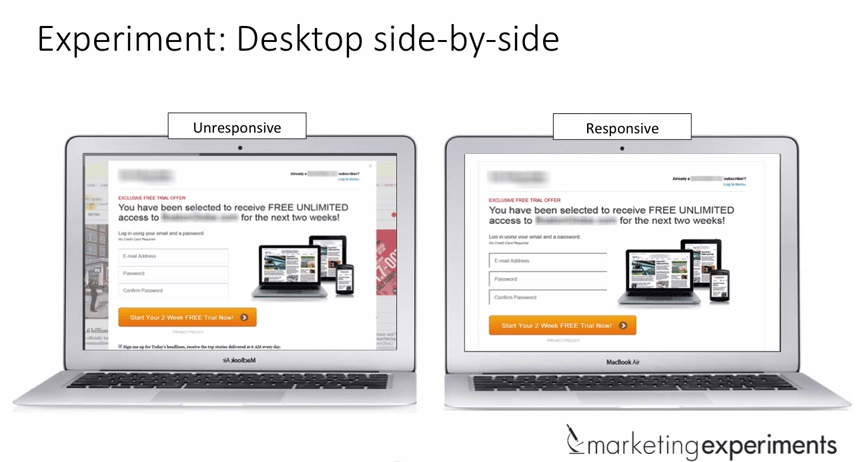While testing the effectiveness of responsive site layouts, the team at Marketing Experiments made a discovery that they were not expecting.
The team implemented a responsive theme and layout to a test subject’s site in order to test how well it performed across mobile and tablet devices. In order for the layout to show up properly across the devices, the layout as it appears on desktop devices was altered. All of the special offer information remained the same, but rather than giving the offer in a pop-over/lightbox, the layout made it seem like just another page. The team wasn’t necessarily expecting a huge increase in desktop conversions, but this is what they saw:
Having a responsive site isn’t that noticeable, or essential, when you’re accessing it from a desktop device. So why did this test result in so many conversions? The team speculates it had to do with the absence of the pop-over, or at least the absence of the pop-over appearance.
Pop-overs have been a favorite with digital marketers for a while now, but the jump in conversion the Marketing Experiments team experienced made us wonder, are pop-overs losing their effectiveness? We decided to speak with other digital marketers to see if pop-overs are still effective with their site visitors and got very interesting responses.
Pop-overs are effective…
“As a nonprofit marketer, we began using a lightbox during our quarterly fundraising campaigns in Dec. 2012. 67% of all the online donations made to the campaign in Dec. 2013 were a result of a website visitor clicking on the lightbox that went directly to our donation form. We found that this graphic call-to-action provided an easy way to capture people who wanted to complete a simple action on our site so we made it highly visible and quick to complete their gift.” – Christina Relacion, Communications Manager, Scleroderma Foundation
“I own several blogs and Internet marketing websites and find that my email list opt-in rates are consistently 45-50% higher with the use of pop-ups.” – Ken Mabry, LongTailBlogging.com
…but they appear to be more effective for certain demographics…
“The effectiveness of these elements depend on what demographic uses your website. In North America, for Gen Y and younger uses, the conversion goes down. For other users, it goes up. Two of my projects come to mind: 1) REW.ca – A real estate site that promotes sign ups and newsletter opt ins via lightboxes. This increased our numbers. The demographic for this site is homeowners, so it tends to hit an older audience. 2) Kidzworld.com – A social media site for kids. Lightboxes were not effective and did not make a change to registration numbers. Instead, we saw user complaints on the forum.” – Chenny Xia, UX Designer
…when used in moderation…
“We will continue to use the lightbox as part of our online giving strategy, but we think it is more effective because it is a tool that we only use once each quarter and it isn’t something that is standard on our site during the rest of the year.” – Christina Relacion, Communications Manager, Scleroderma Foundation
…and when used discretely.
“I try to keep them as discrete and unobtrusive as possible. I use top-quality plugins to generate opt-in forms for my blog sites and hire professional designers for my other web properties. I believe the key to successful implementation is to respect your readers–giving them the opportunity to collapse the opt-in form or presenting them with the popup only once per visit.” – Ken Mabry, LongTailBlogging.com
But their effectiveness may be waning.
“In my experience, overlay ads have never been an effective means of registering newsletter sign-ups or click through conversions. Ultimately, such a means of promotion interrupts and blocks the users’ experience.” – Grayson De Ritis, Owner / Creative Lead, De Ritis Media
“We’ve tested versions of pop-overs and found they increase conversion, but also increase churn/quitters. I recommend people track those users before blindly implementing it. How do the subscribers that come from pop-overs compare to others: Do they open your emails, click on the links, or ever buy your products? Do they share on social media? We can track all these things. And this is not an isolated case. My theory is it reduced trust, and since our service depends on trust, pop-overs actually hurt active users. We saw a relatively higher portion of them, despite signing up, never again came back.” – Andre Pinantoan, Growth Hacker, Getpocketbook.com
What are your thoughts? Are site visitors still just as eager to sign up using pop-overs, or is the death of the pop-over near?


